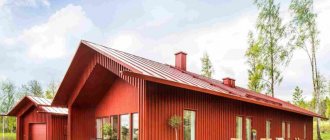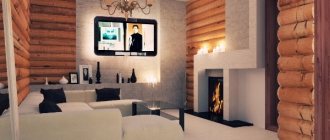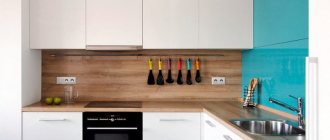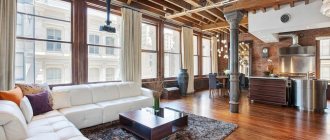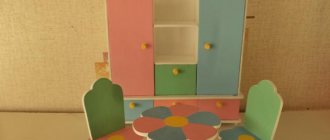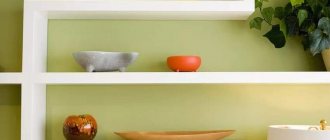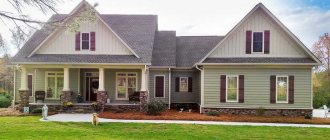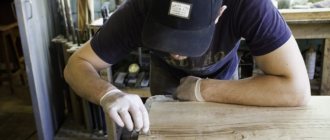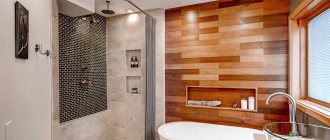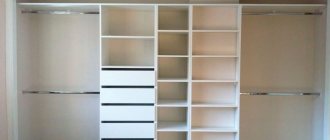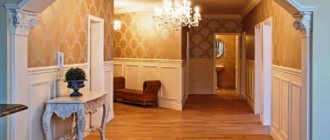Types of wall panels for interior decoration
Cladding walls with panels helps to make repairs quickly, get excellent results and significantly save on the cost of repairs. After all, they can cover up the lack of plaster, uneven corners and other possible construction flaws. With an abundance of choice, deciding which materials to use is not easy. Let's figure out which types and why are the most interesting today, and what to give preference to.
Slatted panels
Such panels are used to decorate any premises, except, perhaps, for children. The length of the planks ranges from 2.4 to 3.6 m, the width from 12.5 to 30 cm, the thickness of the planks is 8-12 mm. They can be white or colored, imitating various types of wood. Indispensable for rooms with a small area and many corners. Slat panels easily cover internal and external corners. Tenons or grooves are used to connect the slats to each other. To make the joints invisible, manufacturers offer a huge number of corners, plugs, baseboards and other products that make installation simple and neat; with minimal experience, you can do it yourself.
When installing plastic wall panels for interior decoration, plugs and corners will hide the seams and complement the overall picture if chosen correctly Source liveposts.ru
Slatted wall panels made of wood are called “lining” and are actively used. They can be covered with stain or varnish, or simply painted, creating an extraordinary interior. Often the lining is given the effect of aged wood. Recently, the popularity of “lining” has decreased slightly, giving way to more modern materials, but dachas, summer kitchens and loggias are finished with this type of cladding.
Leafy
This species is distinguished by its large size. But it allows you to quickly install panels over a large area. Sheets 122x244 cm and 6 mm thick are made from multi-layer fiberboard with various impregnations or from PVC. They often imitate stone, wood and are attached to the wall with glue. They are light, durable, and you don’t need to make lathing for their installation.
Imitation brick or stone in wall panels for interior decoration - always look original Source kreotech.de
Tiled
Cladding with tiled panels allows you to give the walls volume, obtain relief images, and with their help you can create an absolutely unique interior. Interlocking connections make it possible to obtain large-area wall coverings from small slabs (90x90 cm, 30x30 cm). They imitate expensive wood species or natural stone. They are often used to decorate living rooms and fireplace areas.
Wooden panels for interior wall decoration from different “tree species” Source decoratorist.com
Projects of houses with panel finishing
Number of projects 61
- 4 rooms
- 2 bathrooms
Frame house project 007
- To favorites
- 102² Total area
- 9 x 7m Construction area
from 1,377,000 rub.
Construction time individually
- 4 rooms
- 2 bathrooms
Half-timbered House Project
- To favorites
- 107² Total area
- 8 x 8m Construction area
from 1,737,900 rub.
Construction time individually
High rating
- 4 rooms
- 2 bathrooms
Project Versailles
- To favorites
- 150² Total area
from 3,226,000 rub.
Construction time individually
- 3 rooms
- 2 bathrooms
Frame house project 010
- To favorites
- 112² Total area
- 7 x 9m Construction area
from 1,512,000 rub.
Construction time individually
- 4 rooms
- 1 bathroom
Frame house project 005
- To favorites
- 76² Total area
- 10 x 8m Construction area
from 1,026,000 rub.
Construction time individually
Available at the exhibition
- 5 rooms
- 2 bathrooms
Project of the House Ekaterina
- To favorites
- 121.16² Total area
- 10 x 7m Construction area
from 1,450,000 rub.
Construction time individually
- 5 rooms
- 2 bathrooms
Frame house project 017
- To favorites
- 157² Total area
- 11 x 9m Construction area
from 2,119,500 rub.
Construction time individually
- 5 rooms
- 2 bathrooms
Frame house project 016
- To favorites
- 148² Total area
- 9 x 9m Construction area
from 1,998,000 rub.
Construction time individually
- 3 rooms
- 1 bathroom
Terem House Project
- To favorites
- 108² Total area
- 9 x 6m Construction area
from 747,600 rub.
Construction time individually
Available at the exhibition
- 6 rooms
- 2 bathrooms
Toronto House Project
- To favorites
- 115² Total area
- 8 x 8m Construction area
from 970,000 rub.
Construction time individually
- 5 rooms
- 2 bathrooms
House Project Zurich-1
- To favorites
- 171² Total area
- 9 x 9m Construction area
from 1,460,000 rub.
Construction time individually
- 3 rooms
- 2 bathrooms
Project of the Avenche House with facade
- To favorites
- 144² Total area
- 8 x 9m Construction area
from 1,834,000 rub.
Construction time individually
- 5 rooms
- 2 bathrooms
Frame house project 018
- To favorites
- 167² Total area
- 11 x 11m Construction area
from 2,254,500 rub.
Construction time individually
- 3 rooms
- 2 bathrooms
Manderfeld House Project
- To favorites
- 207² Total area
- 13 x 8m Construction area
from 1,647,000 rub.
Construction time individually
- 3 rooms
- 2 bathrooms
House Project Basel
- To favorites
- 117² Total area
- 8 x 8m Construction area
from 1,150,000 rub.
Construction time individually
- 4 rooms
- 2 bathrooms
Frame house project 015
- To favorites
- 122² Total area
- 13 x 10m Construction area
from 1,647,000 rub.
Construction time individually
- 5 rooms
- 2 bathrooms
Schwyz House Project
- To favorites
- 137² Total area
- 8 x 9m Construction area
from 1,120,000 rub.
Construction time individually
- 4 rooms
- 2 bathrooms
Altdorf House Project
- To favorites
- 192² Total area
- 11 x 9m Construction area
from 1,490,000 rub.
Construction time individually
- 2 rooms
- 1 bathroom
Frame house project 011
- To favorites
- 94² Total area
- 10 x 10m Construction area
from 1,269,000 rub.
Construction time individually
- 4 rooms
- 1 bathroom
Frame house project 026
- To favorites
- 87² Total area
- 9 x 6m Construction area
from 1,174,500 rub.
Construction time individually
View all projects
The use of facade panels in the exterior decoration of a house Source samstroy.com
Exterior decoration of a house, in most cases, is an integral part of construction or renovation. There are a variety of finishing materials on the market with different characteristics and prices. One of the most popular types are facade panels.
They will not only give the building a beautiful, attractive appearance, but also protect the walls from the destructive effects of the environment, and also enhance the sound and heat insulation properties of the building. But before buying, first of all, you should pay attention to the properties and qualities of the exterior finish. That is why, even before ordering panel cladding for your home, you should take a closer look at the material and study all its advantages and disadvantages.
What materials are they made from?
Decorative wall panels are made from chipboard, fiberboard, MDF or PVC.
Today, new materials for their manufacture appear almost every day. Panels made of stone chips appeared, and glass panels also found their admirers. Which material to choose can only be determined if you have the necessary information.
On our website you can find contacts of construction companies that offer house design services. You can communicate directly with representatives by visiting the “Low-Rise Country” exhibition of houses.
Tree
Wood has been used for the manufacture of cladding for a very long time. Initially, such panels were made from solid wood, were expensive and inaccessible to most buyers. Today you can buy combined wooden panels, the cost of which is much lower. The front layer of such products is valuable types of wood applied to a pine or spruce base. The development of technology has made it possible to produce similar high-quality finishing materials from waste from the woodworking industry (sawdust, wood chips). This made it possible to decorate walls in rooms imitating expensive types of wood, very inexpensively. Wood-look wall panels are appropriate in any interior. However, cladding with natural wood has not lost its relevance and can favorably emphasize the status of the owner of the room.
Panels for interior decoration with natural wood cladding always look expensive Source geenen.de
Chipboard and fiberboard boards
Quite cheap material. Chipboards and wood-fiber boards, as these well-known abbreviations stand for, can add warmth and sound insulation to a room, decorate it, however, the high content of formaldehyde resins in the boards, unstable outer coating and rapid deformation from moisture and steam have greatly reduced the popularity of this material for finishing recently.
Chipboard and fiberboard are more often used to level walls for finishing. Source rusvoin.ru
MDF
This is a more modern improved version of chipboard. It is sometimes mistakenly called modified plywood. The company Medium Density Fiberboard was the first to produce this material. The first three letters form its name. Instead of formaldehyde resins, vegetable lignin is used in production. MDF panels are more durable and can withstand high humidity better. They have a very long service life, are easy to maintain and do not emit harmful compounds into the air.
The panels can be varnished; they are often veneered with valuable wood species, laminated or coated with water-repellent compounds. The material can withstand heavy loads; heavy objects, such as paintings or bookshelves, can be mounted on them without fear. Today, such panels are used more often in the decoration of office premises, in home decoration; I want something more refined and at the same time cozy.
MDF panels are more often found in office premises Source picz.ge
PVC panels
The cheapest way to decorate a room. Any hardware store can offer a huge selection of similar finishing materials. Bright, with different patterns, imitating wood and plain, they are not afraid of dampness. They are often used to decorate kitchens and bathrooms. The quality of PVC panels offered to consumers has also improved significantly. Today they do not fade; higher quality plastic is used in production. When choosing, it is better to give preference to Russian or European manufacturers.
The disadvantage is that the abundance of plastic in the house can increase the humidity in it; for finishing living rooms (living room, children's room, bedroom), it is better to use more environmentally friendly and natural materials.
Partial finishing with PVC panels also looks beautiful Source prosto-remont.net
Wall panels: buy in the online store
As for the catalog of decorative wall panels, we must pay tribute to the age of this idea - to decorate walls. Even in ancient times, so-called bas-reliefs appeared - special protruding architectural decorations. And today we all have a unique opportunity to decorate the walls of our homes and offices according to our own discretion and taste, because the boundaries of decoration have expanded, and the interior in any style has become more accessible.
Decorative panels for walls have a wide selection of patterns and textures, and are also made from materials with different properties. All wall decors are presented in our showroom in St. Petersburg and Moscow; and in the online store where you can buy the product you like. Let's take a closer look at these types of panels:
Shop wall panels: types, let's look at gypsum panels first
If we talk about gypsum panels, we can note such qualities as:
· Spectacular volume.
· Possibility of repeated repainting.
· Ability to completely or partially replace modules.
· Harmless from an environmental point of view.
· Convenience and ease of installation.
To all of the above advantages, you can add one more: gypsum is not flammable, since it does not contain any additional elements such as phenol, styrene or formaldehyde.
The cost of this type of panels can be classified as economy class, which makes them affordable for most buyers. Installation conveniences include the visual absence of seams and joints.
An interesting fact is that gypsum wall modules help regulate the humidity in the room: if it is high, the gypsum absorbs moisture; if, on the contrary, it releases it.
The possibility of repeated painting is also a very powerful argument in favor of gypsum panels, because remodeling the interior will require less financial and time costs.
Panels on the wall: photos in the interior
Although the history of using fabric as decorative wall decoration is far from new, soft wall panels have become widespread only in the last decade.
It is not for nothing that modern designers assign such an important role to them in interior design and interior decoration. By using soft panels for interior wall decoration, even in the most ordinary and unremarkable room setting, you can easily turn it into a bright and memorable corner with a unique charm.
If we talk about the advantages of this type of wall panels, we can name the following:
1. Increasing the sound and heat insulation of the room.
2. The ability to finish all surfaces, including podiums and ceilings, which will be a long-awaited find for lovers of extravagant style.
3. Wall products made from this material are perfect for zoning a room; they can be used to decorate both entire walls and individual parts of them.
4. Installation will not even be carried out by a professional.
5. Any defects possible on the walls will be securely hidden from prying eyes.
What materials are usually used in the manufacture of this type of wall panels?
If we are talking about cladding, in other words, about the surface, then the following are usually used:
· A natural skin.
· Leatherette.
· Textiles.
There’s not much to say about genuine leather, because it speaks for itself. Leather wall panels will fit perfectly with any type of plain or colored wallpaper and will add sophistication and luxury to the interior. Without exaggeration, this option for wall decoration can be called one of the most expensive.
Don’t immediately write off leatherette. Despite the much lower cost, wall materials made from it look very impressive and are also easy to clean. The possibility of wet cleaning is generally a big plus; besides, under soft panels made “to look like leather” you can not only hide surface imperfections, but also hide, for example, electrical wiring.
Textile covering will help in creating a harmonious interior, but only the fabric must be wear-resistant and durable so that over time it does not stretch, does not sag and can withstand certain regular loads. Therefore, special attention must be paid to the quality of the fabric.
As for the filler for wall panels of this type, foam rubber or synthetic winterizer is usually used.
Foam rubber should be preferred if your room has softer walls. For example, if you are decorating a children's room. Sintepon weighs less, so it has its own advantage: it remains immune to deformation and sagging of the product longer.
Polyurethane: lightweight panels for ceilings and walls
Designers recommend this material to decorate the inside of a room of any functional purpose: apartments, country houses, offices. It is not only practical, but also stylish.
Here are the main strengths of polyurethane panels:
1. They are durable, do not deform due to temperature changes, and are immune to high humidity, mechanical and biological damage.
2. Installation is carried out without much effort due to the fact that they are light in weight and have a format convenient for installation, both for walls and ceilings. They can be attached to any material, which also greatly simplifies the installation process.
3. Polyurethane is an excellent heat insulator, keeps cold out of the room and saves heat.
4. The design of these decorative finishing materials can be safely called exclusive.
Polyurethane panels are perfect for both private and public interiors. They can be installed in residential and non-residential premises, in kitchens and bathrooms. If you have imagination and desire, then polyurethane wall panels can be used:
· As a facing material for the lower part of walls. A similar design solution in combination with stucco molding, cornices and other elements will well emphasize the classic style of your home.
· As a complete wall finish. In this case, it is better to use plain panels or ones that imitate wood grain.
· As a panel, with the effect of 3D panels for walls
Decorating with polyurethane panels is an interesting search for new combinations and fertile ground for personal creativity.
Wall panels with 3D effect in the interior with photos
Of course, in our review we cannot ignore such a fashionable look as 3D wall panels. Nowadays, this once incredible visual effect of volume has become characteristic not only of foreign and domestic animation, but also of works of fine art, but also of decorative finishing materials. For example, 3D floors are popular today, but we are now talking about 3D panels for walls.
Modern production capabilities of building materials make it possible to achieve a high level of imitation of almost any texture and create the most complex images in a three-dimensional version. To obtain the most effective result, it is necessary to consistently perform three technological stages:
· Develop a 3D relief.
· Process the selected material according to the specified parameters.
· Complete decorative finishing.
3D models are built using special computer programs based on design sketches. After this, the location of the pattern, its depth and other nuances regarding the future image are worked out on the selected material. For final finishing, decorative materials such as enamels, paints, leather, valuable wood veneer, PVC film and others are used.
What are 3D wall panels usually made from? We can name at least five main types of decorative materials that are successfully used in production. Here they are:
1. Various polymers. Like any plastic wall panels, such products are easy to maintain, durable and moisture resistant.
2. Aluminum. To achieve a volume effect, perforation is used in the manufacture of aluminum panels. The front side of the sheet can be laminated using a polymer film. Such wall products are non-flammable, anti-corrosion and do not cause any problems in terms of contamination, because they get dirty very little.
3. Chipboard. It is best used in rooms with low humidity. When finishing interiors, they are exposed to temperature changes, which negatively affects their durability and appearance.
4. Fiberboard. By analogy, it is similar to chipboard; these products do not like moisture, and getting water on them is highly undesirable.
5. MDF. Wall panels made of this material protect well from moisture and have excellent strength.
6. Wood. Everyone knows that natural wood is a safe material, environmentally friendly and highly durable. To make the performance characteristics even better, it must be treated with a special varnish or wax.
7. Plaster. For this type, fine fraction material is used, to which the necessary plasticizers are added. Thanks to its natural properties and production technology, it is highly resistant to any level of moisture and steam, and maintains the indoor microclimate at a healthy level.
And just a few more words about the advantages of 3D panels for walls, which can be called basic. There are seven of them:
1. They have a high safety margin.
2. Eco-friendly and non-flammable.
3. They resist mechanical damage well.
4. They have excellent sound and heat insulation properties.
5. Hides any wall defects and imperfections on the surface without requiring its preliminary preparation.
6. There are many options for final wall finishing: from painting to decorative plaster.
7. Easy to install and easy to maintain.
Thus, it is safe to conclude that wall panels with a 3D effect not only make an unforgettable visual impression, but are also truly practical.
Isotex wood fiber wall and ceiling panels
Separately, I would like to say about the now popular Isotex panels, produced using Finnish technology. In European countries, they have long enjoyed great success due to their versatility and affordable cost.
These are universal decorative boards that are used for both walls and ceilings. Their main strength is excellent sound and thermal insulation and maximum ease of installation. You can install them not only on your own, but even without the help of a partner, alone.
Such decorative panels for walls will find irreplaceable use in a nursery or in a room where they like to listen to loud music. These wall products not only muffle sounds, but also “remove” the so-called echo effect, which has a good effect on the acoustics in the room. To achieve the optimal level of this property, experts recommend using wall panels with a textile coating.
Such slabs can be safely washed, painted, and in case of any defect, replaced not entirely, but in segments, which greatly simplifies the task of finishing the room.
The main advantages of wall and ceiling panels from Finnish developers are as follows:
· Wide range of use: suitable for both finishing apartments and finishing houses of any type.
· There is no need to pre-prepare the walls before installation.
· Minimum amount of construction waste after installation.
· Installation does not require special professional skills or experience.
· Due to the lightness of the product - about 1 kg 200 g - installation can be carried out by one person.
· Resistance to humidity.
The last point is especially relevant for owners of country houses, where temperature fluctuations are often observed and the level of humidity in the room also changes frequently. Isotex wall and ceiling panels will not deform due to these unpleasant moments and will last a long time.
3D panels
This type of finishing is at the peak of popularity today. Volumetric mosaic created from different materials (wood, glass, plaster, plastic) allows you to add sophistication to the room. At the same time, the materials used to make the panels can be completely natural, they do not cause allergies, are easy to clean and retain their original appearance for a long time.
Your renovation will still look fresh and neat in a few years. They look great in the bedroom and living room and will create a voluminous fairy tale in your child’s room. They do not deform and are not afraid of dampness. Easy to install, you can choose a finish in a suitable price category. They fit perfectly into any room and can be used to create a variety of interior styles.
3D gypsum panels have their own twist Source roomester.ru
Clinker
The type of finish imitates brick or natural stone. Made from clay in a special oven. This stone has the following advantages and disadvantages:
- resistance to abrasion and mechanical damage and scratches;
- strength;
- long service life (clinker stone can last about the same as ceramic brick);
- resistance to fading in the sun;
- the ability to use clinker in regions with cold climates, since it is not afraid of low temperatures and sudden changes;
- stone or brick finishing has a high density and is moisture resistant;
- environmentally friendly material
- the stone is easy to install;
- wide range of colors and textures;
- high price;
- decorative stone weighs more than plastic counterparts.
Joining clinker panels
Finishing a stone or brick wall is mounted using a dry or wet method . With the wet laying method, extruded polystyrene foam is used as the base for the tiles. It is mounted on the walls before cladding work begins. The thickness of the thermal insulation is determined by calculation. Cement glue is applied to the surface of the insulation, which holds the artificial stone in the designed position.
With the dry method, mineral wool is used as insulation. Its installation on the wall surface is carried out using a metal frame. A clinker panel is subsequently attached to this frame from the inside. Fastening is done with self-tapping screws or dowels.
The dry method of fixing clinker under stone is preferable, since mineral wool does not interfere with the movement of air through the walls. When using insulation made from extruded polystyrene foam, there is a possibility of disrupting ventilation in the building and creating a greenhouse effect.
Advantages and disadvantages of finishing with wall panels
Finishing walls with wall panels has several advantages, you should pay attention to them when planning a renovation:
- easy and quick to install;
- there is no need for expensive leveling of walls, plastering, labor-intensive removal of corners, all problems of the walls will be hidden;
- durable and easy to use;
- give full scope for imagination and unexpected design solutions;
- increase heat and sound insulation in the room;
- easy to clean;
- cables, of which there are many in our homes, are perfectly hidden under them.
There is only one drawback: when they are installed on the sheathing, the area of the room is reduced. If this is not noticeable in large rooms, then for rooms with a small area it can become a problem.
This might be interesting!
In the article at the following link, read about SIP panels.
When installing gypsum vinyl wall panels for interior decoration, up to 5 cm can be lost from each wall Source aviarydecor.com
Façade panel options
Panels for the facade of a house are classified according to several characteristics:
- in shape - rectangular, narrow elongated panels or a medium-sized module;
- according to texture - like stone, brick, wood, for painting;
- by the presence of thermal insulation - with or without insulation;
- according to the method of fastening - panels with a locking mechanism or those that do not require fixation with each other;
- by material - composite, polymers, metal, glass.
Metal
They can be made of aluminum or galvanized stainless steel with a polymer coating. They are not subject to corrosion, are not afraid of moisture, do not burn, and are easy to install. The main disadvantage is the lack of thermal insulation capabilities, as well as susceptibility to deformation.
Metal siding to look like wood Source 2gis.ru
Polymer
Polymer or PVC panels
- the cheapest and most popular option for facade finishing. They have a wide range of colors and are also available in versions that imitate natural materials. Plastic panels for home decoration are very light and easy to install, in addition, they have a long shelf life.
This might be interesting!
In the article at the following link, read about facade panels for finishing a house.
To protect against loss of color under the influence of ultraviolet radiation, polyvinyl chloride requires the addition of special substances to the composition, and if the manufacturer skimps on additives, the material will fade in the sun.
An example of the use of polymer boards Source venezia.od.ua
Composite
This type of panels is gaining popularity today. They are available in a variety of colors and textures, capable of realizing numerous design ideas.
They are made of aluminum, galvanized metal, fiber cement, clinker, porcelain stoneware. Composite boards are not subject to rust or delamination, have a long service life, do not require special care, and are affordable.
Colored facade panels for exterior home decoration Source dearchitect.nl
Glass panels
Glass wall decoration is used less frequently than others due to the high cost and complexity of installation. The material is tempered, impact-resistant, frosted, reinforced glass. In most cases, they are used in cladding the facades of entertainment and shopping centers, highlighting the building and attracting attention.
Cladding panels for glass facades Source sovas.ru
Sandwich panels
This material is a construction of two layers, between which there is a thermal insulation material. Sandwich panels have a very attractive aesthetic appearance, good thermal insulation properties, moisture resistance, sound insulation, fire safety, lightness, durability, and frost resistance.
An example of what a sandwich looks like - panels for exterior decoration of the facade of a house Source paneligid.ru
This might be interesting!
In the article at the following link, read about stone-look facade panels.
Clay
A popular material today that can give a house an expensive and attractive look, make it original and protect the walls. The properties of a clay facade are similar to those of a brick or stone finish. They are frost-resistant, durable, practical, and protect the building from heat loss.
Clay panels for finishing the facades of private houses Source pinterest.com
Clinker
The basis of such panels is clinker tiles, which provide heat conservation, even with temperature changes. Clinker panels are very durable, easy to install, durable, moisture resistant, and not susceptible to fungi and mold. They are made from natural material and therefore cost more. Installation work can be carried out at any time of the year, regardless of the wall material. The facade made of clinker tiles can be presented in different colors and textures. The slabs are fastened to the wall using adhesive mortar, dowels, brackets, screws, and nails.
Clinker facade panels for exterior finishing Source domstroi.info
Fiber cement
The basis of such panels is cement. Additionally, they are covered with a protective layer on both sides. The material of such finishing will last a long time, as it is highly durable, even when exposed to various weather conditions and temperature changes. The panels are fire-resistant, environmentally friendly, and are available on the market in a variety of colors.
Fiber siding in the decoration of house walls Source drevonsk.ru
What to consider when choosing
The most important thing when choosing wall panels is that they must comply with sanitary standards and not be a fire hazard.
Toxicity, flammability, and smoke level must be indicated on the label. The value is from 1 to 4, the higher it is, the worse the quality of the product.
When planning a renovation, decide which panels you want to see in your home. Do they have any other function besides decorative, is the environmental friendliness of the material from which the panels are made important to you and, finally, how much are you willing to pay for them. For example, decorative glass panels in the kitchen should not only decorate the room, but also protect the wall above the stove from grease and steam.
Materials from which wall panels are made
The type of material from which the plates are made is an important factor when choosing a product. After all, it affects the properties of the plates.
Tree
Wood has been used for wall cladding for a long time, but the natural material is highly expensive. And modern technologies have made it possible to combine cheaper rocks with expensive ones to create plates. Therefore, the price of the plates is strikingly different from similar natural materials. Wood grain suits many styles.
Wood grain suits many styles.
MDF
MDF panels are safe for humans, so they can be safely used for residential premises. They have heat and sound insulating properties, are durable, and imitate a wooden surface at the highest level. Construction work is also easy to carry out.
MDF panels are safe for humans, so they can be safely used for residential premises.
PVC
PVC wall plates are made either as slabs or sheets. You can find plates of various widths on sale. They are absolutely safe for human health, easy to clean, moisture-resistant, lightweight and come in a variety of colors.
They are absolutely safe for human health, easy to clean, and moisture resistant.
Chipboard and fibreboard
They are distinguished by their low price and ease of installation. The presence of formaldehyde resins in the composition reduces their positive qualities. They have noise-insulating and heat-insulating properties. It should be noted that they are unstable, when exposed to vapor and humidity, they quickly lose their attractive appearance and become deformed.
They have noise-insulating and heat-insulating properties.
Plaster
Indoors, gypsum plates create an excellent coating that will help regulate the microclimate. But they are not suitable for rooms with high humidity. It is difficult to care for, but if you use special products, care will become easier. They have good thermal insulation and sound insulation. It is possible to replace an individual plate without removing the entire finish.
Indoors, gypsum plates create an excellent coating that will help regulate the microclimate.
Bamboo
A natural material that is becoming increasingly popular. Non-flammable, environmentally friendly, durable, affordable price and easy to install. All these characteristics make bamboo so popular. But not everyone may like this type of decor; it all depends on individual preferences.
A natural material that is becoming increasingly popular.
Metal
Metal plates are made from non-ferrous or regular metal and can be mounted on the ceiling of a wall. Create a unique room design. Easy to install, you can choose a square or rectangle shape. May have a perforated pattern.
Create a unique room design.
Glass and mirror
Mirror panels are also becoming more and more popular; they are easy to install, flexible, but require frequent wiping. Glass and mirror types are made in different shades, give the room an unusual look, and visually increase the space.
They give the room an unusual look and visually increase the space.
Concrete
Concrete plates are used when styling rooms under high-tech and minimalism. They are flexible and easy to install. Durable and reliable. Special forms can be used to give an interesting decorative look to the concrete.
Concrete plates are used when styling rooms under high-tech and minimalism.
Other possible materials
You can also note gypsum vinyl plates; on the outside, the gypsum is covered with vinyl material. They are durable and strong, and withstand mechanical stress well. May be of different colors. You can also note their moisture resistance.
They are durable and strong, and withstand mechanical stress well.
In addition, cork panels are becoming popular. Cork has a unique pattern and is an eco-friendly material that can give a pleasant appearance to a room.
In addition, there is a fabric look.
This is an eco-friendly material that can give a pleasant appearance to the room.
Video description
Example of stone veneer panels in the video:
For the nursery, choose natural materials. The room in which the baby spends most of his time must be safe.
Don't buy the cheapest panels. Their service life is more than one year, let them be beautiful and of high quality so that the results of the repair bring pleasure. When purchasing, pay close attention to the appearance; there should be no chips or cracks. Choose materials from the same batch to avoid shade differences. Various types of wall panels for interior decoration allow you not to limit yourself in choice.
The choice of color and material allows your imagination to run wild Source rockstroy.ru
Why are finishing panels needed?
Decorative paneling
Wall panels are a finishing building material for decorative design of the surfaces of buildings and structures (inside and outside).
In interior decoration they perform the following functions:
- Decorate the interior
- Strengthen the protection of walls
- Hides defects on vertical surfaces
- Insulate and soundproof the room
Panels for interior decoration
Advantages of finishing cladding over other materials:
- levels the surface of the wall without plaster or putty (unlike wallpaper)
- easy installation in a short time
- covering a large area with one finishing element
- provides additional noise and heat insulation
- helps hide communications
- universal (suitable for both residential and commercial premises)
- durable and resistant to mechanical stress
- economical option, but does not look cheap
- easy and convenient to clean from dirt
- can be attached in different directions
- adaptable to different types of walls - can be mounted both vertically and diagonally
- imitates natural materials well
- You can apply photo printing or give different textures
- large selection of models, textures, colors
About fastening features
The next thing to pay attention to is how the panels are supposed to be attached to the wall. You can fasten it with glue, or assemble a sheathing to which individual parts will be mounted.
Lathing is a special structure made of wooden bars or metal profiles. It is attached to the wall with dowels and is the basis for fastening wall panels.
If the room is damp and cold, it is better to choose aluminum profiles. A wooden structure in such conditions quickly becomes unusable. For dry and warm rooms, the sheathing is made of wood.
Plastic and slatted panels for internal wall cladding are attached to each other using a tongue-and-groove locking connection.
A wooden sheathing is erected, panels are attached to its slats using clamps (this is what special brackets are called). Sometimes parquet nails or screws are used for fastening.
Fastening of panels "groove-groove". To join the panels, special plastic or metal profiles are used, which after installation perform a decorative function.
Gaps during groove-to-groove joining, even if they are noticeable, look neat Source aligrande.kz When joining “groove-to-groove”, the gaps between materials are almost invisible Source rusvoin.ru
If the wall is smooth and it is supposed to be covered with soft panels made of fabric or leather, you can use glue. Typically, “liquid nails” are used for installation. During the next renovation, cleaning the walls in this case may require additional effort. It will have to be leveled. Light sheet wall panels for interior decoration can also be mounted using glue.
Important!
The panels can only be glued to perfectly flat walls.
How photo panels are attached
Depending on what interior detail the photopanel is intended for, the appropriate mount is selected.
Photo facades for screens, cabinets and partitions are inserted into a special aluminum profile frame. Kitchen facades are glued to a base made of MDF, chipboard or PVC.
When making paneled facades, photo panels are fixed in a special recess cut into a base made of chipboard, PVC or MDF. Such facades are a bit like paintings with frames.
There are also several options for mounting the photopanel on the wall. If the wall has a perfectly flat surface (which is rare), then installation is carried out using liquid nails. For uneven walls, an additional structure consisting of an aluminum profile and guides will be required. Photo posters are often installed using picture fittings with a standard 4-point fastening.
